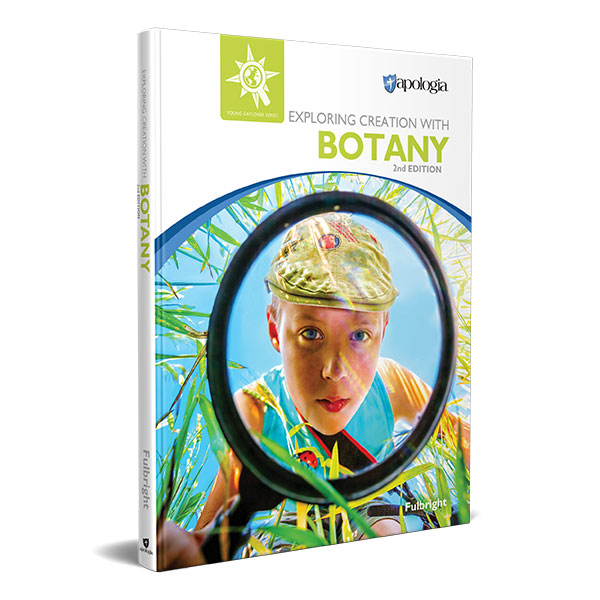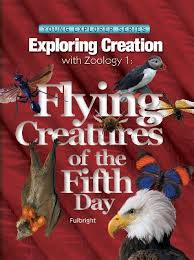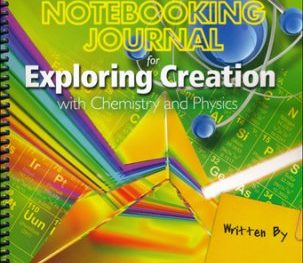This Charlotte Mason-styled living book will help you cultivate a love of learning in your homeschool as you study God’s incredible world of plants. Written in the Apologia conversational style, this hands-on and engaging botany course begins with a lesson on the nature of botany and the process of classifying plants. It then discusses the development of plants from seeds, the reproduction processes in plants, the way plants make their food, and how plants get their water and nutrients and distribute them throughout the body of the plant. As students study these topics, they also learn about many types of plants in creation and where they belong in the plant classification system.
When your family reads this science book you are studying important information discovered by great scientists throughout history. Keeping a student Notebooking Journal helps your child to document studies in their own words. Additionally, participating in science activities builds upon that knowledge as your child conducts their own scientific studies. It is our prayer that at the end of the year your child will have gained a deeper appreciation for and understanding of the beauty of creation.
Features of Exploring Creation with Botany, 2nd Edition
- Increased focus on nature journaling
- New chapters on gardening and mycology
- Wide variety of new and updated activities to fit any writing level and learning style
- Engaging and fun Minibooks to illustrate and assemble
- All new spectacular photos and graphics
- A Suggested Daily Schedule that makes lesson planning a breeze
- Improved layout that is more user-friendly, regardless of the climate in which you live
There are 14 lessons included in this one-year botany course. A detailed daily lesson plan is included in the Notebooking Journal.
Lesson topics include:
- Nature Journaling
- The Science of Botany
- Seeded and Seedless Plants
- Grouping Plants
- Seeds and Germination
- Angiosperms – Flowering Plants
- Flower Families
- Pollination
- Seeds
- Fruits and Vegetables
- Leaves, Photosynthesis, Transpiration
- Roots and Root Systems
- Stems
- Gardening
- Trees
- Gymnosperms
- Seedless & Vascular Plants
- Mycology
This botany course for elementary grades is packed with a variety of hands-on activities, experiments, and projects. These can be completed with household materials. You can view the complete list of lab supplies by viewing the sample here.
The gardening chapter is especially exciting. There is an activity on building a raised garden, so you do not need a lot of room for a garden. As always, we encourage you to modify the course and its activities to fit your family’s specific needs. For example, your family could grow a container garden.
What Are Some of the Activities in This Botany Course?
The Exploring Creation with Botany, 2nd Edition, course is designed to provide fun, educational, and safe activities for you to conduct in your home, yard, and surrounding environments. The activities and projects use easy-to-find household items and truly make the lessons come alive!
There are over 75 different activities and projects from which to choose. A sampling of the course projects include:
- Create a Nature Journal
- Make a Tree Field Guide
- Build a Light Hut
- Preserve Flowers
- Grow Edible Mushrooms
- Create a Garden Journal
- Build lichenometer
- Design a Garden Plan
- Plant and Harvest a Garden
What is the Daily Schedule for Botany?
We have provided a detailed daily schedule for Botany in the front of each Notebooking Journal and Junior Notebooking Journal. This schedule specifically outlines what to read and what activities to complete. This course is designed to be done 2 days a week, approximately 1 hour each day. The suggested daily schedule, found in the student Notebooking Journal, is for 28 weeks. We suggest you modify this schedule to fit your family’s specific needs. Each lesson should take approximately 1 hour. Some lessons have activities or outdoor adventures, which will require more time.
We recommend that you spend the entire school year covering this book, devoting approximately two sessions per week to the course. Please note that many of the activities and projects in this book are long-term with results that can take several days to observe. Thus, you will have to be flexible in how you schedule your time.






Reviews
There are no reviews yet.